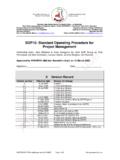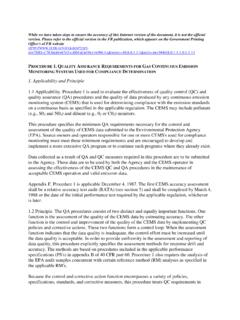Transcription of The SURVEYMEANS Procedure - SAS
1 SAS/STAT User s GuideThe SURVEYMEANSP rocedureThis document is an individual chapter fromSAS/STAT User s correct bibliographic citation for this manual is as follows: SAS Institute Inc. User s Guide. Cary, NC:SAS Institute User s GuideCopyright 2016, SAS Institute Inc., Cary, NC, USAAll Rights Reserved. Produced in the United States of a hard-copy book: No part of this publication may be reproduced, stored in a retrieval system, or transmitted, in any form or byany means, electronic, mechanical, photocopying, or otherwise, without the prior written permission of the publisher, SAS a web download or e-book: Your use of this publication shall be governed by the terms established by the vendor at the timeyou acquire this scanning, uploading, and distribution of this book via the Internet or any other means without the permission of the publisher isillegal and punishable by law.
2 Please purchase only authorized electronic editions and do not participate in or encourage electronicpiracy of copyrighted materials. Your support of others rights is Government License Rights; Restricted Rights:The Software and its documentation is commercial computer softwaredeveloped at private expense and is provided with RESTRICTED RIGHTS to the United States Government. Use, duplication, ordisclosure of the Software by the United States Government is subject to the license terms of this Agreement pursuant to, asapplicable, FAR , DFAR (a), DFAR (a), and DFAR , and, to the extent required under law, the minimum restricted rights as set out in FAR (DEC 2007). If FAR is applicable, this provisionserves as notice under clause (c) thereof and no other notice is required to be affixed to the Software or documentation.
3 TheGovernment s rights in Software and documentation shall be only those set forth in this Institute Inc., SAS Campus Drive, Cary, NC 27513-2414 November 2016 SAS and all other SAS Institute Inc. product or service names are registered trademarks or trademarks of SAS Institute Inc. in theUSA and other countries. indicates USA brand and product names are trademarks of their respective software may be provided with certain third-party software, including but not limited to open-source software, which islicensed under its applicable third-party software license agreement. For license information about third-party software distributedwith SAS software, refer 114 The SURVEYMEANS ProcedureContentsOverview: SURVEYMEANS Procedure .
4 9242 Getting Started: SURVEYMEANS Procedure ..9242 Simple Random Sampling ..9242 Stratified Sampling ..9245 output Data Sets ..9247 Syntax: SURVEYMEANS Procedure ..9248 PROC SURVEYMEANS Statement ..9249BY Statement ..9261 CLASS Statement ..9262 CLUSTER Statement ..9262 DOMAIN Statement ..9263 POSTSTRATA Statement ..9265 RATIO Statement ..9267 REPWEIGHTS Statement ..9268 STRATA Statement ..9270 VAR Statement ..9271 WEIGHT Statement ..9271 Details: SURVEYMEANS Procedure ..9272 Missing Values ..9272 Survey Data Analysis ..9273 Statistical Computations ..9274 Replication Methods for Variance Estimation ..9301 Computational Resources ..9306 output Data Sets ..9307 Displayed output .
5 9310 ODS Table Names ..9316 ODS Graphics ..9317 Examples: SURVEYMEANS Procedure ..9318 Example : Stratified Cluster Sample Design ..9318 Example : Domain Analysis ..9321 Example : Ratio Analysis ..9325 Example : Analyzing Survey Data with Missing Values ..9325 Example : Variance Estimation Using Replication Methods ..9327 Example : Comparing Domain Means ..9330 References ..93349242 FChapter 114: The SURVEYMEANS ProcedureOverview: SURVEYMEANS ProcedureThe SURVEYMEANS Procedure estimates characteristics of a survey population by using statistics computedfrom a survey sample. It enables you to estimate statistics such as means, totals, proportions, quantiles,geometric means, and ratios. PROC SURVEYMEANS also provides domain analysis, which computesestimates for subpopulations or domains.
6 PROC SURVEYMEANS also estimates variances and confidencelimits and performsttests for these statistics. PROC SURVEYMEANS uses either the Taylor series(linearization) method or replication (subsampling) methods to estimate sampling errors of estimators basedon complex sample designs. The sample design can be a complex survey sample design with stratification,clustering, and unequal weighting. For more information, see Fuller (2009); Lohr (2010); S rndal, Swensson,and Wretman (1992); Wolter (2007).PROC SURVEYMEANS uses the output Delivery System (ODS), a SAS subsystem that provides capabilitiesfor displaying and controlling the output from SAS procedures . ODS enables you to convert any of theoutput from PROC SURVEYMEANS into a SAS data set.
7 For more information, see the section ODS TableNames on page SURVEYMEANS uses ODS Graphics to create graphs as part of its output . For general informationabout ODS Graphics, see Chapter 21, Statistical Graphics Using ODS. For specific information about thestatistical graphics available with the SURVEYMEANS Procedure , see the PLOTS= option in the PROCSURVEYMEANS statement and the section ODS Graphics on page Started: SURVEYMEANS ProcedureThis section demonstrates how you can use the SURVEYMEANS Procedure to produce descriptive statisticsfrom sample survey data. For a complete description of PROC SURVEYMEANS , see the section Syntax: SURVEYMEANS Procedure on page 9248. The section Examples: SURVEYMEANS Procedure onpage 9318 provides more complicated examples to illustrate the applications of PROC Random SamplingThis example illustrates how you can use PROC SURVEYMEANS to estimate population means andproportions from sample survey data.
8 The study population is a junior high school with a total of 4,000students in grades 7, 8, and 9. Researchers want to know how much these students spend weekly for icecream, on average, and what percentage of students spend at least $10 weekly for ice answer these questions, 40 students were selected from the entire student population by using simplerandom sampling (SRS). Selection by simple random sampling means that all students have an equal chanceof being selected and no student can be selected more than once. Each student selected for the sample wasasked how much he or she spends for ice cream per week, on average. The SAS data setIceCreamsaves theresponses of the 40 students:Simple Random SamplingF9243data IceCream;input Grade Spending @@;if (Spending < 10) then Group='less';else Group='more';datalines;7 7 7 7 8 12 9 10 7 1 7 10 7 3 8 20 8 19 7 27 2 9 15 8 16 7 6 7 6 7 6 9 15 8 17 8 14 9 89 8 9 7 7 3 7 12 7 4 9 14 8 18 9 9 7 2 7 17 4 7 11 9 8 8 10 8 13 7 2 9 6 9 11 7 2 7 9;The variableGradecontains a student s grade.
9 The variableSpendingcontains a student s response regardinghow much he spends per week for ice cream, in dollars. The variableGroupis created to indicate whethera student spends at least $10 weekly for ice cream:Group= more if a student spends at least $10, orGroup= less if a student spends less than $ can use PROC SURVEYMEANS to produce estimates for the entire student population, based on thisrandom sample of 40 students:ods graphics on;title1 'Analysis of Ice Cream Spending';title2 'Simple Random Sample Design';proc SURVEYMEANS data=IceCream total=4000;var Spending Group;run;The PROC SURVEYMEANS statement invokes the Procedure . The TOTAL=4000 option specifies thetotal number of students in the study population, or school.
10 PROC SURVEYMEANS uses this total toadjust variance estimates for the effects of sampling from a finite population. The VAR statement names thevariables to analyze, displays the results from this analysis. There are a total of 40 observations used in the Class Level Information table lists the two levels of the variableGroup. This variable is a charactervariable, and so PROC SURVEYMEANS provides a categorical analysis for it, estimating the relativefrequency or proportion for each level. If you want a categorical analysis for a numeric variable, you canname that variable in the CLASS of Ice Cream SpendingAnalysisofIceCreamSpendingSimple RandomSampleDesignTheSURVEYMEANSP rocedureAnalysisofIceCreamSpendingSimple RandomSampleDesignTheSURVEYMEANSP rocedureData SummaryNumber of Observations40 Class Level InformationCLASSV ariableLevelsValuesGroup2less more9244 FChapter 114: The SURVEYMEANS ProcedureFigure CL for Statistics table displays the estimates for each analysis variable.















